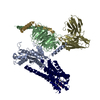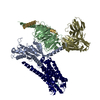+ データを開く
データを開く
- 基本情報
基本情報
| 登録情報 | データベース: PDB / ID: 8zjd | ||||||
|---|---|---|---|---|---|---|---|
| タイトル | Cryo-EM structure of kisspeptin receptor bound to KP-10 | ||||||
 要素 要素 |
| ||||||
 キーワード キーワード | MEMBRANE PROTEIN / Cryo-EM / kisspeptin receptor / GPR54 / KISS1R / G proteins | ||||||
| 機能・相同性 |  機能・相同性情報 機能・相同性情報Fatty Acids bound to GPR40 (FFAR1) regulate insulin secretion / Acetylcholine regulates insulin secretion / phospholipase C-activating G protein-coupled glutamate receptor signaling pathway / neuropeptide receptor activity / PLC beta mediated events / phospholipase C-activating serotonin receptor signaling pathway / entrainment of circadian clock / regulation of platelet activation / G protein-coupled peptide receptor activity / regulation of canonical Wnt signaling pathway ...Fatty Acids bound to GPR40 (FFAR1) regulate insulin secretion / Acetylcholine regulates insulin secretion / phospholipase C-activating G protein-coupled glutamate receptor signaling pathway / neuropeptide receptor activity / PLC beta mediated events / phospholipase C-activating serotonin receptor signaling pathway / entrainment of circadian clock / regulation of platelet activation / G protein-coupled peptide receptor activity / regulation of canonical Wnt signaling pathway / glutamate receptor signaling pathway / phototransduction, visible light / photoreceptor outer segment / neuropeptide signaling pathway / postsynaptic cytosol / adenylate cyclase inhibitor activity / positive regulation of protein localization to cell cortex / Adenylate cyclase inhibitory pathway / T cell migration / D2 dopamine receptor binding / response to prostaglandin E / enzyme regulator activity / adenylate cyclase regulator activity / G protein-coupled serotonin receptor binding / adenylate cyclase-inhibiting serotonin receptor signaling pathway / cellular response to forskolin / GTPase activator activity / regulation of mitotic spindle organization / Peptide ligand-binding receptors / Turbulent (oscillatory, disturbed) flow shear stress activates signaling by PIEZO1 and integrins in endothelial cells / Regulation of insulin secretion / positive regulation of cholesterol biosynthetic process / negative regulation of insulin secretion / G protein-coupled receptor binding / response to peptide hormone / adenylate cyclase-inhibiting G protein-coupled receptor signaling pathway / adenylate cyclase-modulating G protein-coupled receptor signaling pathway / G-protein beta/gamma-subunit complex binding / centriolar satellite / Olfactory Signaling Pathway / Activation of the phototransduction cascade / G beta:gamma signalling through PLC beta / Presynaptic function of Kainate receptors / Thromboxane signalling through TP receptor / G protein-coupled acetylcholine receptor signaling pathway / G-protein activation / adenylate cyclase-activating G protein-coupled receptor signaling pathway / Activation of G protein gated Potassium channels / Inhibition of voltage gated Ca2+ channels via Gbeta/gamma subunits / Prostacyclin signalling through prostacyclin receptor / G beta:gamma signalling through CDC42 / Glucagon signaling in metabolic regulation / G beta:gamma signalling through BTK / Synthesis, secretion, and inactivation of Glucagon-like Peptide-1 (GLP-1) / ADP signalling through P2Y purinoceptor 12 / photoreceptor disc membrane / Sensory perception of sweet, bitter, and umami (glutamate) taste / blood coagulation / Glucagon-type ligand receptors / Adrenaline,noradrenaline inhibits insulin secretion / Vasopressin regulates renal water homeostasis via Aquaporins / GDP binding / Glucagon-like Peptide-1 (GLP1) regulates insulin secretion / G alpha (z) signalling events / cellular response to catecholamine stimulus / ADP signalling through P2Y purinoceptor 1 / ADORA2B mediated anti-inflammatory cytokines production / G beta:gamma signalling through PI3Kgamma / Cooperation of PDCL (PhLP1) and TRiC/CCT in G-protein beta folding / adenylate cyclase-activating dopamine receptor signaling pathway / GPER1 signaling / Inactivation, recovery and regulation of the phototransduction cascade / cellular response to prostaglandin E stimulus / G-protein beta-subunit binding / heterotrimeric G-protein complex / G alpha (12/13) signalling events / sensory perception of taste / extracellular vesicle / signaling receptor complex adaptor activity / Thrombin signalling through proteinase activated receptors (PARs) / retina development in camera-type eye / G protein activity / GTPase binding / Ca2+ pathway / fibroblast proliferation / midbody / High laminar flow shear stress activates signaling by PIEZO1 and PECAM1:CDH5:KDR in endothelial cells / cell cortex / G alpha (i) signalling events / nuclear membrane / G alpha (s) signalling events / phospholipase C-activating G protein-coupled receptor signaling pathway / G alpha (q) signalling events / 加水分解酵素; 酸無水物に作用; GTPに作用・細胞または細胞小器官の運動に関与 / Ras protein signal transduction / Extra-nuclear estrogen signaling / cell population proliferation / protein stabilization / cilium / ciliary basal body 類似検索 - 分子機能 | ||||||
| 生物種 |  Homo sapiens (ヒト) Homo sapiens (ヒト) synthetic construct (人工物) | ||||||
| 手法 | 電子顕微鏡法 / 単粒子再構成法 / クライオ電子顕微鏡法 / 解像度: 3.06 Å | ||||||
 データ登録者 データ登録者 | Shen, S. / Liu, H. / Xu, H.E. | ||||||
| 資金援助 |  中国, 1件 中国, 1件
| ||||||
 引用 引用 |  ジャーナル: Cell Rep / 年: 2024 ジャーナル: Cell Rep / 年: 2024タイトル: Structural basis for hormone recognition and distinctive Gq protein coupling by the kisspeptin receptor. 著者: Shiyi Shen / Dongxue Wang / Heng Liu / Xinheng He / Yinglong Cao / Juanhua Chen / Shujie Li / Xi Cheng / H Eric Xu / Jia Duan /  要旨: Kisspeptin signaling through its G protein-coupled receptor, KISS1R, plays an indispensable role in regulating reproduction via the hypothalamic-pituitary-gonadal axis. Dysregulation of this pathway ...Kisspeptin signaling through its G protein-coupled receptor, KISS1R, plays an indispensable role in regulating reproduction via the hypothalamic-pituitary-gonadal axis. Dysregulation of this pathway underlies severe disorders like infertility and precocious puberty. Here, we present cryo-EM structures of KISS1R bound to the endogenous agonist kisspeptin-10 and a synthetic analog TAK-448. These structures reveal pivotal interactions between peptide ligands and KISS1R extracellular loops for receptor activation. Both peptides exhibit a conserved binding mode, unveiling their common activation mechanism. Intriguingly, KISS1R displays a distinct 40° angular deviation in its intracellular TM6 region compared to other G-coupled receptors, enabling distinct interactions with G. This study reveals the molecular intricacies governing ligand binding and activation of KISS1R, while highlighting its exceptional ability to couple with G. Our findings pave the way for structure-guided design of therapeutics targeting this physiologically indispensable receptor. | ||||||
| 履歴 |
|
- 構造の表示
構造の表示
| 構造ビューア | 分子:  Molmil Molmil Jmol/JSmol Jmol/JSmol |
|---|
- ダウンロードとリンク
ダウンロードとリンク
- ダウンロード
ダウンロード
| PDBx/mmCIF形式 |  8zjd.cif.gz 8zjd.cif.gz | 240.8 KB | 表示 |  PDBx/mmCIF形式 PDBx/mmCIF形式 |
|---|---|---|---|---|
| PDB形式 |  pdb8zjd.ent.gz pdb8zjd.ent.gz | 183.7 KB | 表示 |  PDB形式 PDB形式 |
| PDBx/mmJSON形式 |  8zjd.json.gz 8zjd.json.gz | ツリー表示 |  PDBx/mmJSON形式 PDBx/mmJSON形式 | |
| その他 |  その他のダウンロード その他のダウンロード |
-検証レポート
| 文書・要旨 |  8zjd_validation.pdf.gz 8zjd_validation.pdf.gz | 387.9 KB | 表示 |  wwPDB検証レポート wwPDB検証レポート |
|---|---|---|---|---|
| 文書・詳細版 |  8zjd_full_validation.pdf.gz 8zjd_full_validation.pdf.gz | 395.7 KB | 表示 | |
| XML形式データ |  8zjd_validation.xml.gz 8zjd_validation.xml.gz | 21.9 KB | 表示 | |
| CIF形式データ |  8zjd_validation.cif.gz 8zjd_validation.cif.gz | 33.8 KB | 表示 | |
| アーカイブディレクトリ |  https://data.pdbj.org/pub/pdb/validation_reports/zj/8zjd https://data.pdbj.org/pub/pdb/validation_reports/zj/8zjd ftp://data.pdbj.org/pub/pdb/validation_reports/zj/8zjd ftp://data.pdbj.org/pub/pdb/validation_reports/zj/8zjd | HTTPS FTP |
-関連構造データ
| 関連構造データ |  60141MC  8zjeC M: このデータのモデリングに利用したマップデータ C: 同じ文献を引用 ( |
|---|---|
| 類似構造データ | 類似検索 - 機能・相同性  F&H 検索 F&H 検索 |
- リンク
リンク
- 集合体
集合体
| 登録構造単位 | 
|
|---|---|
| 1 |
|
- 要素
要素
-Guanine nucleotide-binding protein ... , 3種, 3分子 BGA
| #3: タンパク質 | 分子量: 38744.371 Da / 分子数: 1 / 由来タイプ: 組換発現 / 由来: (組換発現)  Homo sapiens (ヒト) / 遺伝子: GNB1 Homo sapiens (ヒト) / 遺伝子: GNB1発現宿主:  参照: UniProt: P62873 |
|---|---|
| #5: タンパク質 | 分子量: 7861.143 Da / 分子数: 1 / 由来タイプ: 組換発現 / 由来: (組換発現)  Homo sapiens (ヒト) / 遺伝子: GNG2 Homo sapiens (ヒト) / 遺伝子: GNG2発現宿主:  参照: UniProt: P59768 |
| #6: タンパク質 | 分子量: 41312.922 Da / 分子数: 1 / 由来タイプ: 組換発現 詳細: fusion protein of Guanine nucleotide-binding protein G(i) subunit alpha-1 and Guanine nucleotide-binding protein G(q) subunit alpha-q. 由来: (組換発現)  Homo sapiens (ヒト) / 遺伝子: GNAI1, GNAQ, GAQ Homo sapiens (ヒト) / 遺伝子: GNAI1, GNAQ, GAQ発現宿主:  参照: UniProt: P63096, UniProt: P50148 |
-タンパク質 / タンパク質・ペプチド / 抗体 , 3種, 3分子 RLS
| #1: タンパク質 | 分子量: 55953.941 Da / 分子数: 1 / 由来タイプ: 組換発現 / 由来: (組換発現)  Homo sapiens (ヒト) / 遺伝子: KISS1R, AXOR12, GPR54 / 発現宿主: Homo sapiens (ヒト) / 遺伝子: KISS1R, AXOR12, GPR54 / 発現宿主:  Trichoplusia ni (イラクサキンウワバ) / 参照: UniProt: Q969F8 Trichoplusia ni (イラクサキンウワバ) / 参照: UniProt: Q969F8 |
|---|---|
| #2: タンパク質・ペプチド | 分子量: 1375.511 Da / 分子数: 1 / 由来タイプ: 合成 / 由来: (合成) synthetic construct (人工物) |
| #4: 抗体 | 分子量: 26277.299 Da / 分子数: 1 / 由来タイプ: 組換発現 / 由来: (組換発現)  発現宿主:  |
-詳細
| Has protein modification | Y |
|---|
-実験情報
-実験
| 実験 | 手法: 電子顕微鏡法 |
|---|---|
| EM実験 | 試料の集合状態: PARTICLE / 3次元再構成法: 単粒子再構成法 |
- 試料調製
試料調製
| 構成要素 | 名称: Cryo-EM structure of kisspeptin receptor in complex with G proteins タイプ: COMPLEX / Entity ID: all / 由来: RECOMBINANT |
|---|---|
| 由来(天然) | 生物種:  Homo Sapiens (ヒト) Homo Sapiens (ヒト) |
| 由来(組換発現) | 生物種:  |
| 緩衝液 | pH: 7.4 |
| 試料 | 包埋: NO / シャドウイング: NO / 染色: NO / 凍結: YES |
| 急速凍結 | 凍結剤: ETHANE |
- 電子顕微鏡撮影
電子顕微鏡撮影
| 実験機器 |  モデル: Titan Krios / 画像提供: FEI Company |
|---|---|
| 顕微鏡 | モデル: FEI TITAN KRIOS |
| 電子銃 | 電子線源:  FIELD EMISSION GUN / 加速電圧: 300 kV / 照射モード: FLOOD BEAM FIELD EMISSION GUN / 加速電圧: 300 kV / 照射モード: FLOOD BEAM |
| 電子レンズ | モード: DARK FIELD / 最大 デフォーカス(公称値): 2000 nm / 最小 デフォーカス(公称値): 1000 nm |
| 撮影 | 電子線照射量: 50 e/Å2 フィルム・検出器のモデル: FEI FALCON IV (4k x 4k) |
- 解析
解析
| CTF補正 | タイプ: NONE |
|---|---|
| 3次元再構成 | 解像度: 3.06 Å / 解像度の算出法: FSC 0.143 CUT-OFF / 粒子像の数: 199591 / 対称性のタイプ: POINT |
 ムービー
ムービー コントローラー
コントローラー




 PDBj
PDBj































